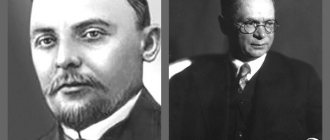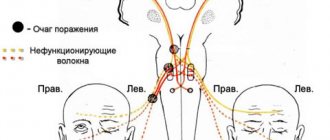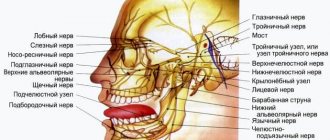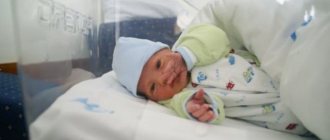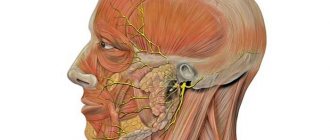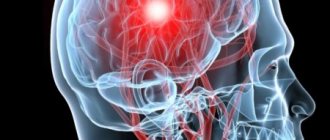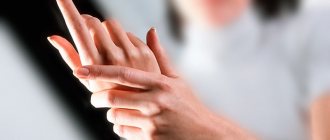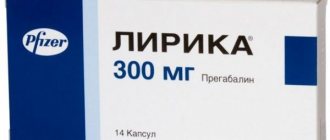Neuritis of the facial nerve is a lesion of the facial nerve, manifested by paralysis of the facial muscles and masticatory muscles on one or both sides. This pathology can occur at any age. Neuritis is an inflammatory disease; it can develop acutely, but more often the symptoms increase gradually. Neuritis is also called Bell's palsy, which means that it causes paresis or paralysis of the facial muscles. Neuralgia of the facial nerve is also possible, which is characterized by paroxysmal pain in the facial area and rapidly progresses. With paresis, the motor function of the facial muscles is reduced, and with paralysis it is completely absent. Neuritis responds well to treatment with complex therapy. Gymnastics plays an important role in neuritis of the facial nerve. Let's look at what it is and why it is performed.
Features of the disease
Neuritis of the facial nerve can be a consequence of the following reasons:
- severe hypothermia;
- inflammation of the middle ear - otitis media;
- cerebrovascular accident;
- a brain tumor;
- temporal bone fracture;
- a number of infectious diseases;
- intoxication.
Neuritis begins acutely. It is manifested by paresis of the facial muscles, pronounced asymmetry of the face, since the “healthy” half pulls over the muscles of the patient. On the affected side, the patient cannot wrinkle his forehead, close his eye, raise his eyebrow, and the nasolabial fold is smoothed out. When trying to smile, the mouth will be pulled in the healthy direction. Sensitivity also decreases while guarding the lesion.
In the first four days, the manifestations of paresis usually increase, then the neurological symptoms stabilize. From the second week, the motor function of the facial muscles begins to recover. As a rule, it takes about a month to fully restore movement.
Complications of facial nerve neuritis occur in 15% of cases. This may be inflammation of the mucous membrane of the eye, contracture of the facial muscles, in which flaccid paralysis becomes spastic. In this case, the face will be skewed towards the affected side, twitching will be felt on it, and muscle tone will increase. Contracture of the paralyzed side is a very serious complication that is difficult to correct.
Prevention of muscle contracture is the correct implementation of electrical procedures, therapeutic massage and special gymnastics. The load must be dosed. If the patient experiences twitching on the affected side, the massage is canceled, and exercise therapy is possible after consulting a neurologist.
At the onset of the disease, exercise therapy is prescribed from the first day, and massage is prescribed after stabilization of the condition.
Features of exercise therapy in the basic stage
Sometimes the consequences of neuritis do not go away completely due to incomplete passage of the nerve impulse. Then you need to continue the exercises of the main stage with the addition of bending and shaking your head from side to side.
You can read about how to deal with inflammation of the trigeminal nerve and the resulting pain syndrome at home in this material.
Anticonvulsants for trigeminal neuralgia are a real salvation. They have a calming and relaxing effect, and most importantly, reduce severe pain.
During the period of residual effects (after 3 months from the onset of the disease), all types of exercise therapy used in the main period continue to be used, with an emphasis on therapeutic exercises, the task of which is to increase muscle activity to recreate maximum symmetry between the unaffected and affected sides of the face. During the same period, the training of muscle efforts in various facial situations increases.
According to summary global medical statistics, facial neuritis is observed in residents of various countries in approximately 2–3% of cases of all diseases of the peripheral nervous system, amounting to 16 to 25 cases per 100 thousand population.
Facial gymnastics for neuritis of the facial nerve
Why do gymnastics for facial nerve paresis? Its main goal is to improve blood circulation in the head and neck area, relax the muscles on the healthy side and stimulate the muscles on the sore side.
Therapeutic gymnastics for facial nerve paresis involves a number of rules:
- It is important to ensure that during exercises only those muscles that produce this movement are used, the rest of the muscles should be relaxed. For example, when baring your teeth, you should not frown your eyebrows, since this creates new neural connections, and this will contribute to the appearance of unwanted friendly facial movements.
- It is important to do the exercises efficiently, preferably in front of a mirror, helping yourself to “correct” your face with your hands and achieving its symmetry.
- After performing this or that movement, relax your facial muscles.
- First, the exercises can be done mentally, and then directly actively. This will give you the opportunity to concentrate and do everything right. Mentally performing exercises additionally activates the nervous system.
- To restore a smile, the doctor may try to make the patient laugh, for example, by telling him a joke. The healthy side of the face should be supported with your hands so that the muscles are relaxed. You need to warn in advance that it will be funny, and attention should be concentrated on the affected side.
Main symptoms
The disease develops rapidly. Neuritis of the facial nerve is divided into primary (occurring for the first time due to hypothermia) and secondary (attached against the background of concomitant diseases). Depending on the degree of damage, the following symptoms appear:
READ ALSO: causes, symptoms and treatment of facial nerve neuropathy
- severe pain in the ear or back of the head,
- throbbing pain in the facial area radiating to various organs, swelling of the face,
- hearing impairment, decreased sensitivity in the ear area or complete lack of sensitivity,
- weakness and paralysis of facial muscles,
- dry eyes or excessive lacrimation,
- increased salivation,
- nervous tic.
Later, characteristic asymmetry of the face appears, protrusion of the eye, inability to close the eye or raise the eyebrow. Eating becomes difficult, taste buds are disrupted. Hearing becomes more acute, all sounds seem unbearably loud.
Exercise therapy for facial neuritis: exercises
Gymnastics for neuritis or neuropathy can be performed individually or in a small group while sitting on a chair. The set of exercises is divided into three parts:
- Exercises for the shoulder girdle. They are performed while sitting on a chair and are aimed at improving blood circulation in the neck and head. These may include moving the arm to the side (while you will need to look at it), placing the hand on the shoulders and rotating the arms clockwise and counterclockwise, raising and lowering the upper shoulder girdle, and so on.
- Special exercises - facial gymnastics for neuritis of the facial nerve, aimed at the facial muscles of the mouth, eyebrows, eyes within the limits of symmetry, while it is important to prevent the face from skewing in the healthy direction. To do this, the muscles of the healthy side need to be intuitively held with your hands, making sure that they do not work completely. On the sore side, the muscles tighten, which helps to achieve normal symmetrical movement.
- Exercises for the articulatory apparatus, which include the pronunciation of certain sounds and words.
Exercises for neuritis of the facial nerve for the facial muscles are performed between general strengthening exercises, since paretic facial muscles tend to get tired quickly.
Breathing exercises also play a role, especially for speech disorders. If the specified movements are difficult to reproduce, galvanization of the nerve exit site with a cathode is used to increase the conductivity of the facial nerve on the affected side. When current passes, facial movements on the affected area are easier. Also, therapeutic exercises can be carried out against the background of thermal procedures.
Preliminary massage
Before starting facial exercises for facial neuritis, it is recommended to get a massage. It involves the following sequence of actions:
- With cleanly washed hands, you need to sit in front of the mirror and begin massaging your forehead. Your movements should be superficial and light, flat, not causing redness of the skin in the forehead area.
- Afterwards, a massage is performed in the area of the eye sockets, during which you need to look down with your eyes closed (on the sore side, close the eye with 2-3 fingers). Start the massage from the inner corner of the eye to the outer and further to the parotid zone.
- Then a massage is performed on the nasal area, starting from the wings of the nose and continuing to the parotid area.
- Massage the area around the mouth: from the center of the mouth to the corner of the jaw.
- Chin massage: from the middle of the chin to the corner of the jaw.
- Neck massage along the front surface.
- Then the head moves forward, backward, and to the sides.
- Young and middle-aged people perform circular movements with their heads.
After the massage, exercises for facial nerve paresis begin. They are performed 5-10 times.
- Forehead wrinkling.
- Closing the eyes.
- Frowning brows.
- Sucking in air through the nose.
- Alternately closing the eyes (winking).
- Movements of the nose are performed, simulating a feeling of dissatisfaction.
- Then you need to bare your teeth.
- Smile from the corner of the mouth (smirk).
- Retraction of the cheeks by the oral cavity.
- Puffing out cheeks.
- Performing movements towards the lower jaw
- The tongue moves in the oral cavity.
- Rinse your mouth with air.
- Then the mouth is rinsed with warm water.
- The lips are pulled forward like a tube.
- Whistling.
- Consonant sounds are pronounced: B, M, P, X, C.
- Vowel sounds are pronounced.
A set of exercises along with a preparatory massage is done every 2-3 hours throughout the day.
Gymnastics for the eyes for facial nerve paresis
- Close your eyes tightly - 30 seconds.
- Squint gaze – 30 seconds.
- Staring eyes - 30 seconds.
- Then a normal look is made.
- Wink 10 times alternately with your left and right eyes.
- Stretch your hand forward, without taking your eyes off your index finger, move it to your nose, and then, touching your index finger with your nose, move your hand away. The exercise is repeated ten times.
- Frown your eyebrows and make a “bright” look.
- Movements of the eyeballs are performed from right to left.
- Using three fingers of each hand, press on the upper eyelid for 1-2 seconds, repeat 3-4 times.
- Using your index fingers, press the skin in the area of the eyebrows and gradually close your eyes. Use your fingers to hold the skin of the brow ridges, providing resistance to the muscles that close the eyes.
- Using your index, middle and ring fingers, which are placed over your open eyes, close them, creating resistance. Repeat 8-10 times.
- Close your eyes and smoothly rotate them in the following sequence: left, up, right, down, then in the opposite direction. Repeat 5-10 times in both directions.
Lip exercises
- Exercise “Lips-Teeth” (the sounds U-I are pronounced), lips in a tube and in a smile.
- The lips, elongated in a tube, turn right and left.
- Raise and lower your upper lip.
- Use your upper lip to scratch your upper teeth.
- The teeth are grinned while the lips are pulled back on the right and left sides.
- Exercise “Coachman” - the sound “prrrrr” is pronounced.
- Whistle.
- Fake spitting.
Tongue exercises
- Raise your tongue up behind your lips and lower it behind your lower teeth.
- Raise your tongue to your upper lip and lower it onto your lower lip.
- Place your tongue on each cheek with your mouth open.
- Exercise “Painter” - you need to stroke the hard palate back and forth with your tongue.
- The lips are licked with the tongue in a circular manner, first clockwise and then counterclockwise.
- Place your tongue between your lips and blow hard.
- Exercise “false candy” - rest your tongue on each cheek.
- Exercise “Delicious jam”: lick jam or honey from your upper lip with your tongue.
- Imitation of a cat lapping milk.
- The “angry turkey” exercise is a quick movement of the tongue along the upper lip with the sounds of bl-bl-bl.
- Exercise “Woodpecker”: the sounds “ttttt”, “td-td-td”, “tdd-tdd-tdd”, “tdd-tdd-tdd” and so on are pronounced.
- It is useful to roll a small cream or radish in your mouth with your tongue.
- Using a brush cleared of bristles, work on the inner walls of the cheeks from the inside.
This facial gymnastics for facial nerve paresis will help you recover from a lesion much faster and forget about its unpleasant symptoms. It is important to do it regularly. Follow all the advice of experts, and then you will be able to minimize the unpleasant consequences of neuritis.
How to treat inflammation of the facial nerve
This type of inflammation occurs when the nerve that controls the facial muscles becomes inflamed or swollen. As a result, the disease leads to the fact that half of the face looks distorted, the smile becomes crooked, and the eyes cannot close completely. When treating complications of inflammation, the symptoms of the disease become less noticeable within a few weeks. Full recovery may take three to six months. Find out how to treat inflammation of the facial nerve right now.
Initially, it is necessary to find out the cause of inflammation of the facial nerve and eliminate it using a set of therapeutic measures that influence not only the etiological factor itself, but also all links in the pathogenesis of the disease.
Drug treatment of inflammation of the facial nerve is designed to relieve swelling, as well as restore blood microcirculation in the nerve trunk. A positive effect can only be achieved if treatment is started in the first days. It is worth noting that after seven days it will no longer be completely effective.
Drug therapy for neuritis
It is necessary to prescribe anti-inflammatory drugs, antispasmodics, and vasodilators. In case of severe pain, analgesics are used to treat inflammation of the facial nerve. To eliminate the inflammatory component, glucocorticoid drugs, for example, prednisolone, are used.
Physiotherapeutic techniques are used as additional treatment methods, such as UHF therapy, ultrasound with hydrocortisone for the affected half of the face and mastoid process, and mud masks for both halves of the face.
According to indications, inflammation is treated with drugs that improve tissue metabolism (Nerobol, Nerobolil, Phenobolin) and metabolism.
In the treatment of neuritis of the facial nerve, vitamins B, PP, C and folic acid, anticholinesterase drugs (Proserin) are widely used to activate metabolism in the nervous tissue, as well as in the vascular walls.
The sooner treatment is prescribed, the better the result will be. In addition, antiviral drugs are used at an early stage. To improve blood supply to the nerve, as well as achieve an anti-inflammatory result, it is recommended to use droppers.
To speed up the treatment of inflammation, do not overcool your head, face, or neck.
Until recovery from inflammation of the facial nerve, you must wear a scarf, hat or scarf in any weather.
During the first weeks, the affected side should be supported with a bandage.
If there is inflammation of the nerve, home treatment during the first week involves rest. However, from the second, some biostimulants are already prescribed, for example, preparations such as aloe. In addition, in case of inflammation of the facial nerve, massage, exercise therapy, paraffin baths are prescribed, and adhesive plaster fixation of the muscles is performed.
Prognosis in the treatment of inflammation of the facial nerve
Most often, the prognosis for neuritis of the facial nerve is favorable. If paralysis persists for more than three months, the likelihood of a full recovery is greatly reduced. Inflammation of the facial nerve after exiting the stylomastoid foramen in the absence of foci of chronic inflammation in the parotid salivary gland, lymph nodes in this area, or various otogenic factors is a condition with the most favorable prognosis in terms of recovery.
The prognosis for treatment becomes unfavorable in the case of neuritis of otogenic or traumatic origin. In this case, recovery may not occur at all. A relatively favorable prognosis is made in the case of a recurrent course of the disease. At the same time, the restoration of lost functions is incomplete and the severity of the disease is observed with each new relapse. If the inferior alveolar nerve is not properly anesthetized, the resulting damage to the facial nerve is quickly treated.

